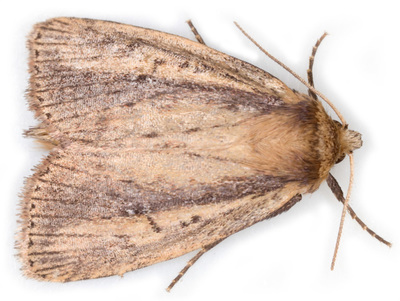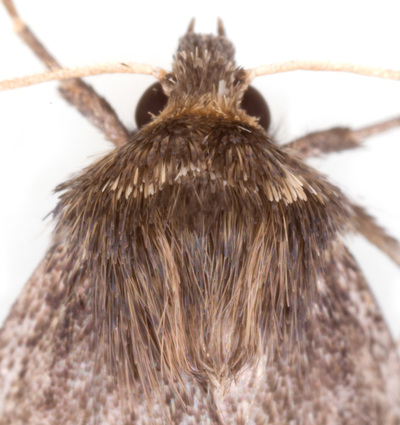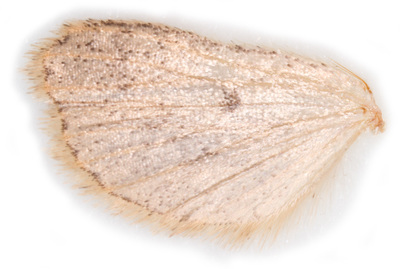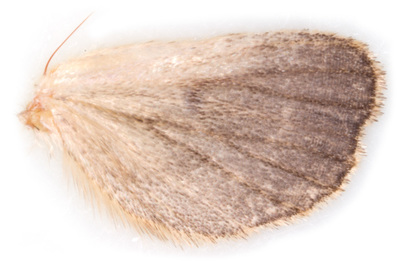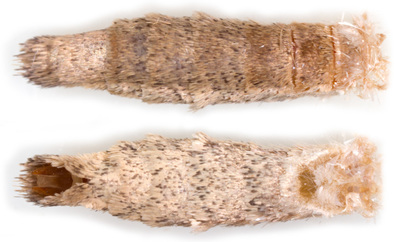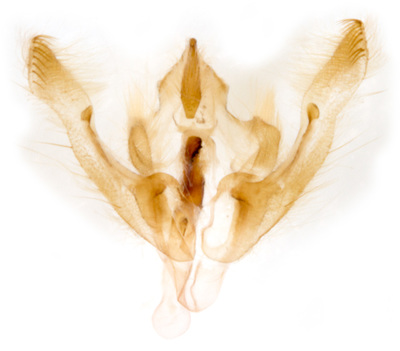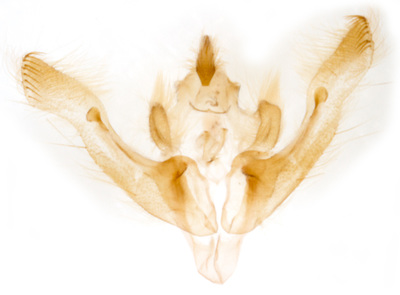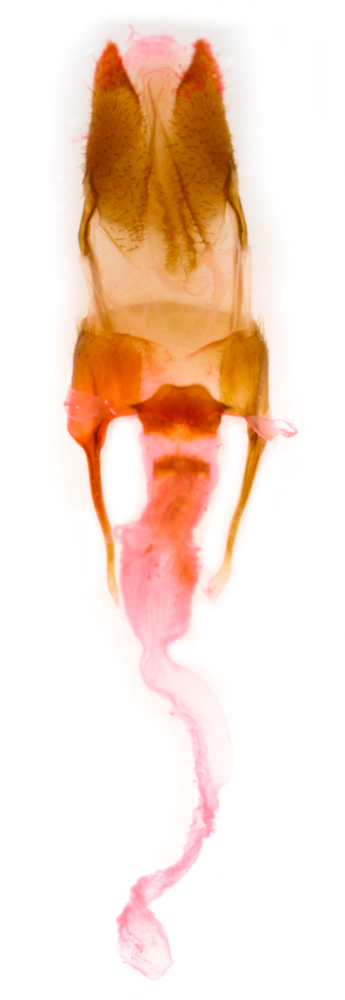73.141 Archanara dissoluta (Brown-veined Wainscot)
fw: 12-15mm (Waring & Townsend), ws: 27-33mm (MBGBI10); Jul-Sep; common reed (Phragmites australis); local in reedbeds in England and Wales.
ID: Form arundineta has forewing ground colour usually whitish-ochreous or reddish-ochreous with a diffuse central black streak from base which doesn’t reach beyond the kidney mark in the female but goes through the kidney mark almost to the termen in the male; kidney mark usually dark, edged white; terminal interneural dark crescents. Form dissoluta is melanic, unmarked apart from an incomplete white outline of the kidney mark. Hindwing fuscous or whitish-fuscous with a blackish terminal line in both forms. Central spot on underside of both forewing an hindwing. Female forewing more elongate and more pointed at apex than in the male. Antenna: male - bisetose-fasciculate, female - finely bisetose.
A.neurica (White-mantled Wainscot) is very similar but has a white collar band (when fresh) and lacks central spots on underside of wings.
MBGBI10 comments that the melanic form dissoluta is rare in Britain, but 25% of specimens I have images for are of this form. MBGBI10 also comments that the patagia are unmarked in A.dissoluta, but I have found that a white posterior margin is sometimes present, especially in the melanic forms (see §1 & §2) - and this could be interpreted as a white collar leading to misidentification as A.neurica if the underside is not checked.
Male genitalia: A.neurica but not A.dissoluta shown at Moth Dissection. A.dissoluta is probably treated in Pierce as "Arundineta; neurica", with A.neurica as "Neurica; edelsteni" - but this synonymy is not mentioned in MBGBI10. Comparing my own material diagnostic differences between the two species, with features of A.neurica given first, are: 1) the distal end of the harpe turns dorsally and ends in a pointed triangle vs turns ventrally and ends in a rounded club; 2) Cucullus with a long rounded lateral spined margin (cucullus slightly broader than it is long) vs cucullus with a short almost straight lateral margin (cucullus clearly longer than broad); 3) Dorsum of valva (costa) with a distinct rounded hump at junction of neck and cucullus vs much more evenly rounded at this junction; 4) Cornutus very close to apex of aedeagus vs cornutus near centre of aedeagal length; 5) Tunica scobinate near apex vs more strongly crested. (Pierce comments regarding A.neurica ("Neurica; edelsteni") "vesica with scobinated process where it joins the aedoeagus at the orifice" and regarding A.dissoluta (Arundineta; neurica) "aedoeagus strongly crested at the orifice"). The image of A.neurica at Moth Dissection is consistent with my observations for the valval features; the aedeagus shown at Moth Dissection, however, does not display the features mentioned here and is inconsistent with Pierce's description.
Female genitalia: A.dissoluta but not A.neurica is shown at Moth Dissection. Treated in Pierce as Meliana dissoluta with A.neurica treated as Meliana neurica, but again this synonymy is not mentioned in MBGBI10. Pierce describes the differences as: A.dissoluta - "..ostium arched; ductus bursae sides parallel longer than in neurica.."; and A.neurica - "..ostium angular, indent; ductus bursae short, bulbed...". The ostium of my two female specimens (see §8 below) is more "angular and indent" than "arched". The illustration in Pierce shows the ductus bursae extending to just beyond the apices of the anterior apophyses in A.dissoluta (as shown below for §7) but much shorter in A.neurica.
A.neurica (White-mantled Wainscot) is very similar but has a white collar band (when fresh) and lacks central spots on underside of wings.
MBGBI10 comments that the melanic form dissoluta is rare in Britain, but 25% of specimens I have images for are of this form. MBGBI10 also comments that the patagia are unmarked in A.dissoluta, but I have found that a white posterior margin is sometimes present, especially in the melanic forms (see §1 & §2) - and this could be interpreted as a white collar leading to misidentification as A.neurica if the underside is not checked.
Male genitalia: A.neurica but not A.dissoluta shown at Moth Dissection. A.dissoluta is probably treated in Pierce as "Arundineta; neurica", with A.neurica as "Neurica; edelsteni" - but this synonymy is not mentioned in MBGBI10. Comparing my own material diagnostic differences between the two species, with features of A.neurica given first, are: 1) the distal end of the harpe turns dorsally and ends in a pointed triangle vs turns ventrally and ends in a rounded club; 2) Cucullus with a long rounded lateral spined margin (cucullus slightly broader than it is long) vs cucullus with a short almost straight lateral margin (cucullus clearly longer than broad); 3) Dorsum of valva (costa) with a distinct rounded hump at junction of neck and cucullus vs much more evenly rounded at this junction; 4) Cornutus very close to apex of aedeagus vs cornutus near centre of aedeagal length; 5) Tunica scobinate near apex vs more strongly crested. (Pierce comments regarding A.neurica ("Neurica; edelsteni") "vesica with scobinated process where it joins the aedoeagus at the orifice" and regarding A.dissoluta (Arundineta; neurica) "aedoeagus strongly crested at the orifice"). The image of A.neurica at Moth Dissection is consistent with my observations for the valval features; the aedeagus shown at Moth Dissection, however, does not display the features mentioned here and is inconsistent with Pierce's description.
Female genitalia: A.dissoluta but not A.neurica is shown at Moth Dissection. Treated in Pierce as Meliana dissoluta with A.neurica treated as Meliana neurica, but again this synonymy is not mentioned in MBGBI10. Pierce describes the differences as: A.dissoluta - "..ostium arched; ductus bursae sides parallel longer than in neurica.."; and A.neurica - "..ostium angular, indent; ductus bursae short, bulbed...". The ostium of my two female specimens (see §8 below) is more "angular and indent" than "arched". The illustration in Pierce shows the ductus bursae extending to just beyond the apices of the anterior apophyses in A.dissoluta (as shown below for §7) but much shorter in A.neurica.
Variation
Dissection
Male genitalia
Female genitalia
§1 Westwood Marsh, Suffolk; 11/08/2015; fw 11.5mm; male; to light
§2 Westwood Marsh, Suffolk; 11/08/2015; fw 10.5mm; male; to light
§3 Strumpshaw Fen, Norfolk; 04/08/2015; male; to light
§4 Westwood Marsh, Suffolk; 11/08/2015; fw 12.2mm; male; to light
§5 Westwood Marsh, Suffolk; 11/08/2015; fw 11.4mm; male; to light
§6 Westwood Marsh, Suffolk; 11/08/2015; fw 11.9mm; male; to light
§7 Westwood Marsh, Suffolk; 11/08/2015; fw 11.9mm; female; to light
§8 Westwood Marsh, Suffolk; 11/08/2015; fw 11.8mm; female; to light
§9 Strumpshaw Fen, Norfolk; 07/08/2015; male; fw 12.8mm; to light
All images © Chris Lewis
§2 Westwood Marsh, Suffolk; 11/08/2015; fw 10.5mm; male; to light
§3 Strumpshaw Fen, Norfolk; 04/08/2015; male; to light
§4 Westwood Marsh, Suffolk; 11/08/2015; fw 12.2mm; male; to light
§5 Westwood Marsh, Suffolk; 11/08/2015; fw 11.4mm; male; to light
§6 Westwood Marsh, Suffolk; 11/08/2015; fw 11.9mm; male; to light
§7 Westwood Marsh, Suffolk; 11/08/2015; fw 11.9mm; female; to light
§8 Westwood Marsh, Suffolk; 11/08/2015; fw 11.8mm; female; to light
§9 Strumpshaw Fen, Norfolk; 07/08/2015; male; fw 12.8mm; to light
All images © Chris Lewis
Page published as draft 18/08/2015 (§1-2), completed 09/03/2016 (§3-8) | §9 added 07/04/2016 | Male genitalia text amended 22/07/2017

